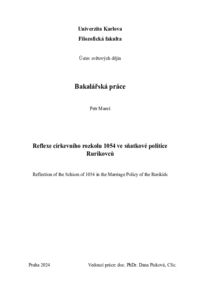Reflexe církevního rozkolu 1054 ve sňatkové politice Rurikovců
Reflection of the Schism of 1054 in the Marriage Policy of the Rurikids
bachelor thesis (DEFENDED)

View/
Permanent link
http://hdl.handle.net/20.500.11956/192160Identifiers
Study Information System: 258985
Collections
- Kvalifikační práce [24984]
Author
Advisor
Referee
Smrž, Pavel
Faculty / Institute
Faculty of Arts
Discipline
History
Department
Institute of General History
Date of defense
14. 6. 2024
Publisher
Univerzita Karlova, Filozofická fakultaLanguage
Czech
Grade
Excellent
Keywords (Czech)
raný ruský stát|církevní rozkol 1054|Jaroslav I. Moudrý|Jaroslaviči|Rurikovci|Polovci, Kumáni|sňatková a dynastická politikaKeywords (English)
Rus'|the Schism of 1054|Yaroslav I. the Wise|Rurikids|Polovtsy, Cumans|Marriage and Dynastic PolicyRoku 1054 došlo k definitivnímu církevnímu rozkolu, v jehož důsledku bylo dokončeno rozdělení středověkého křesťanského světa na latinský katolický Západ a řecký ortodoxní Východ a s konečnou platností se etablovaly dva civilizační okruhy, mezi nimiž se dále prohlubovalo vzájemné neporozumění a odcizení. Lze proto předpokládat, že tento proces musel narušit nebo zcela eliminovat kontakty, které mezi sebou dosud navazovaly formující se státy středověké Evropy, respektive jejich panovníci, kteří se nyní ocitli na opačných stranách bariéry rozdělující latinskou a pravoslavnou sféru. Současně se musela proměnit sňatková politika, která tvořila významnou komponentu těchto vztahů. Předložená práce se zabývá sňatkovou politikou Rurikovců a jejími proměnami v desetiletích následujících po propuknutí církevního rozkolu. Před rokem 1054 uzavírali Rurikovci sňatky s příslušníky panovnických rodů ze Skandinávie, střední, západní i jihovýchodní Evropy. Velký úspěch v tomto ohledu zaznamenal především kníže Jaroslav I. Moudrý, který byl sám ženatý se švédskou princeznou a pro své děti sjednal sňatky s příslušníky panovnických domů v Polsku, v Uhrách nebo ve Francii. Všechny tyto země připadly po církevním rozkolu do civilizační sféry latinského Západu. Naskýtá se proto základní badatelská otázka, jakým způsobem...
In 1054, a definitive ecclesiastical schism took place, as a result of which the division of the medieval Christian world into the Latin Catholic West and the Greek Orthodox East was completed and two civilizational circles were definitively established, between which mutual misunderstanding and alienation deepened. It can therefore be assumed that this process must have disrupted or completely eliminated the contacts that the forming states of medieval Europe, or rather their rulers, who now found themselves on opposite sides of the barrier dividing the Latin and Orthodox spheres, had until now established with each other.At the same time, marriage policy, which formed an important component of these relations, had to change. The present work examines the Rurik marriage policy and its transformations in the decades following the outbreak of the ecclesiastical schism. Prior to 1054, the Rurik family intermarried with members of the ruling families of Scandinavia, Central, Western, and Southeastern Europe. Prince Yaroslav I The Wise was particularly successful in this aspect. Yaroslav, who was himself married to a Swedish princess, arranged marriages for his children with members of royal houses in Poland, Hungary or France. All these countries fell into the sphere of civilization of the Latin West...
